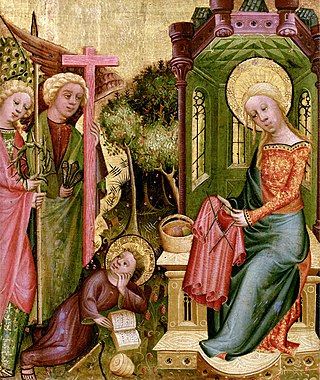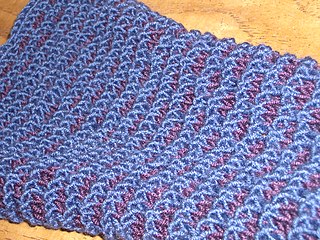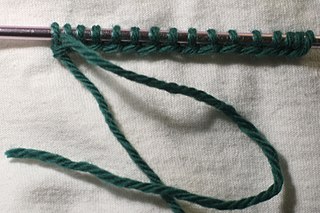Related Research Articles

Knitting is a method for production of textile fabrics by interlacing yarn loops with loops of the same or other yarns. It is used to create many types of garments. Knitting may be done by hand or by machine.

A knitting needle or knitting pin is a tool in hand-knitting to produce knitted fabrics. They generally have a long shaft and taper at their end, but they are not nearly as sharp as sewing needles. Their purpose is two-fold. The long shaft holds the active (unsecured) stitches of the fabric, to prevent them from unravelling, whereas the tapered ends are used to form new stitches. Most commonly, a new stitch is formed by inserting the tapered end through an active stitch, catching a loop of fresh yarn and drawing it through the stitch; this secures the initial stitch and forms a new active stitch in its place. In specialized forms of knitting the needle may be passed between active stitches being held on another needle, or indeed between/through inactive stitches that have been knit previously.

Circular knitting or knitting in the round is a form of knitting that creates a seamless tube. Work in the round is begun by casting on stitches as for flat knitting but then joining the ends of that row of stitches to form a circle. Knitting is worked in rounds, which forms the tube by winding around in a helix.

Knitting is the process of using two or more needles to pull and loop yarn into a series of interconnected loops in order to create a finished garment or some other type of fabric. The word is derived from knot, thought to originate from the Dutch verb knutten, which is similar to the Old English cnyttan, "to knot". Its origins lie in the basic human need for clothing for protection against the elements. More recently, hand knitting has become less a necessary skill and more of a hobby.
Intarsia is a knitting technique used to create patterns with multiple colours. As with the woodworking technique of the same name, fields of different colours and materials appear to be inlaid in one another, fit together like a jigsaw puzzle.
The term "gauge" is used in knitting to describe the fineness size of knitting machines. It is used in both hand knitting and machine knitting. The phrase in both instances refers to the number of stitches per inch rather than the size of the finished article of clothing. The gauge is calculated by counting the stitches or needles across a number of inches, then dividing by the sample's width in inches.
Combined knitting or combination knitting is a knitting method that combines elements of Eastern-style knitting with the Western techniques. The name was suggested by Mary Thomas in her 1938 book "Mary Thomas's Knitting Book", where she described the method as "..the better way to work in Flat Knitting. The resulting fabric is more even and closer in construction." By wrapping the yarn the opposite way while purling, the knitter changes the orientation of the resulting loops; then the next row's knit stitches can be formed by inserting the needle through the back leg, rather than through the front leg, without twisting the stitch. This method is suitable for all knitted fabrics from the basic Stockinette stitch, to any other technique, such as Fair Isle, circular knitting, or lace knitting.

A knitting machine is a device used to create knitted fabrics in a semi or fully automated fashion. There are numerous types of knitting machines, ranging from simple spool or board templates with no moving parts to highly complex mechanisms controlled by electronics. All, however, produce various types of knitted fabrics, usually either flat or tubular, and of varying degrees of complexity. Pattern stitches can be selected by hand manipulation of the needles, push-buttons and dials, mechanical punch cards, or electronic pattern reading devices and computers.

Elizabeth Zimmermann was a British-born hand knitting teacher and designer. She revolutionized the modern practice of knitting through her books and instructional series on American public television.

Slip-stitch knitting is a family of knitting techniques that uses slip stitches to make multiple fabrics simultaneously, to make extra-long stitches, and/or to carry over colors from an earlier row.

In knitting, casting on is a family of techniques for adding new stitches that do not depend on earlier stitches, i.e., having an independent lower edge. In principle, it is the opposite of binding off, but the techniques involved are generally unrelated.

Double knitting is a form of hand knitting in which two fabrics are knitted simultaneously on one pair of needles. The fabrics may be inseparable, as in interlock knitted fabrics, or they can simply be two unconnected fabrics. In principle, an arbitrary number of fabrics can be knitted simultaneously on one pair of knitting needles with yarns, as long as one is careful.
Knitty.com is an online knitting magazine, founded and edited by Amy Sadler and published quarterly since fall 2004.

Spool knitting,loom knitting, corking,French knitting, or tomboy knitting is a form of knitting that uses a spool with a number of nails or pegs around the rim to produce a tube or sheet of fabric. The spool knitting devices are called knitting spools, knitting nancys, knitting frame, knitting loom, or French knitters.
Meg Swansen is a knitting designer, owner of Schoolhouse Press and the daughter of Elizabeth Zimmermann. Similar to her mother, she has helped to popularize knitting and is a well-respected author and knitting teacher, especially at her knitting retreats. Swansen also writes a long-running regular column in Vogue Knitting called "Meg Swansen on...", which covers everything from the Turkish cast on, to lace knitting, to the recherché Scandinavian two-end knitting.
Hand knitting is a form of knitting, in which the knitted fabric is produced by hand using needles.

Cowichan knitting is a form of knitting characteristic of the Cowichan people of southeastern Vancouver Island, British Columbia. The distinctively patterned, heavy-knit Cowichan sweaters, popular among British Columbians and tourists, are produced using this method. Cowichan knitting is an acculturated art form, a combination of European textile techniques and Salish spinning and weaving methods. From this union, new tools, techniques and designs developed over the years.

Jane Gaugain was a Scottish knitter and writer. She built up a successful business in Edinburgh, Scotland, and published 16 volumes on knitting that helped make it a popular pastime for ladies and a source of income for lower classes of women. Her unusually-written pattern books are important in the history of textiles in Scotland.

Henry Josiah Griswold (1837–1929), born in Madison, Connecticut, had a significant role in modifying circular knitting machines. Because of Henry Josiah Griswold, in England, the word "Griswold" became synonymous with domestic circular knitting machines. He founded a hosiery company in 1891 with the name "London and Leicester Hosiery Company" and also leased a factory on Winifred Street in Leicester. Griswold returned to America between 1890 and 1892 and sold his rights to the firm to I. L. Berridge.
Anna Zilboorg is a master knitter and author known for her books about traditional knitting designs and patterns.
References
- 1 2 "Cat Bordhi March 2, 1951 - September 19, 2020". sanjuanislander.com. Retrieved 2020-10-08.
- 1 2 Rosman, Katherine (2020-10-02). "Cat Bordhi, Who Challenged Traditional Ways of Knitting, Dies at 69". The New York Times. ISSN 0362-4331 . Retrieved 2020-10-08.
- ↑ "Cat Bordhi". Yogi Impressions. Retrieved 2020-10-08.
- ↑ "Knitty: Fall 2007". knitty.com. Retrieved 2020-10-08.
- ↑ "Books by Cat Bordhi". www.philosopherswool.com. Retrieved 2020-10-08.
- ↑ "Remembering Cat Bordhi". Knitter's Review. 2020-09-22. Retrieved 2020-10-08.
- ↑ ThriftBooks. "Cat Bordhi Books | List of books by author Cat Bordhi". ThriftBooks. Retrieved 2020-10-08.
- ↑ "Cat Bordhi Retreat Details" (PDF). peralynnainn.com. Archived (PDF) from the original on 2012-04-17.